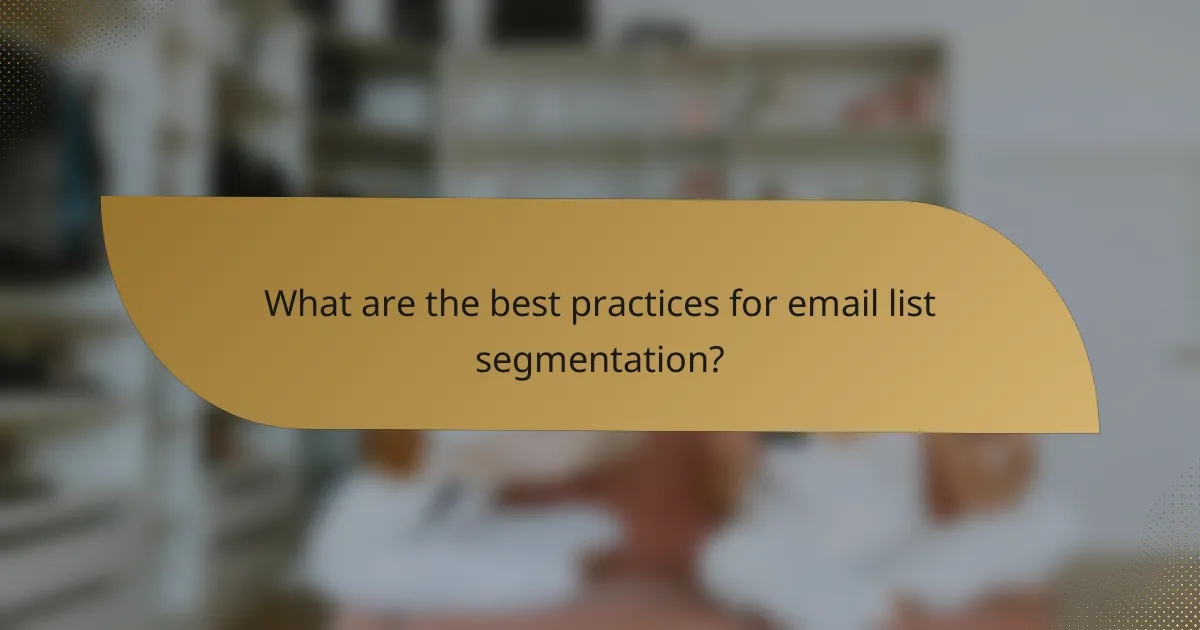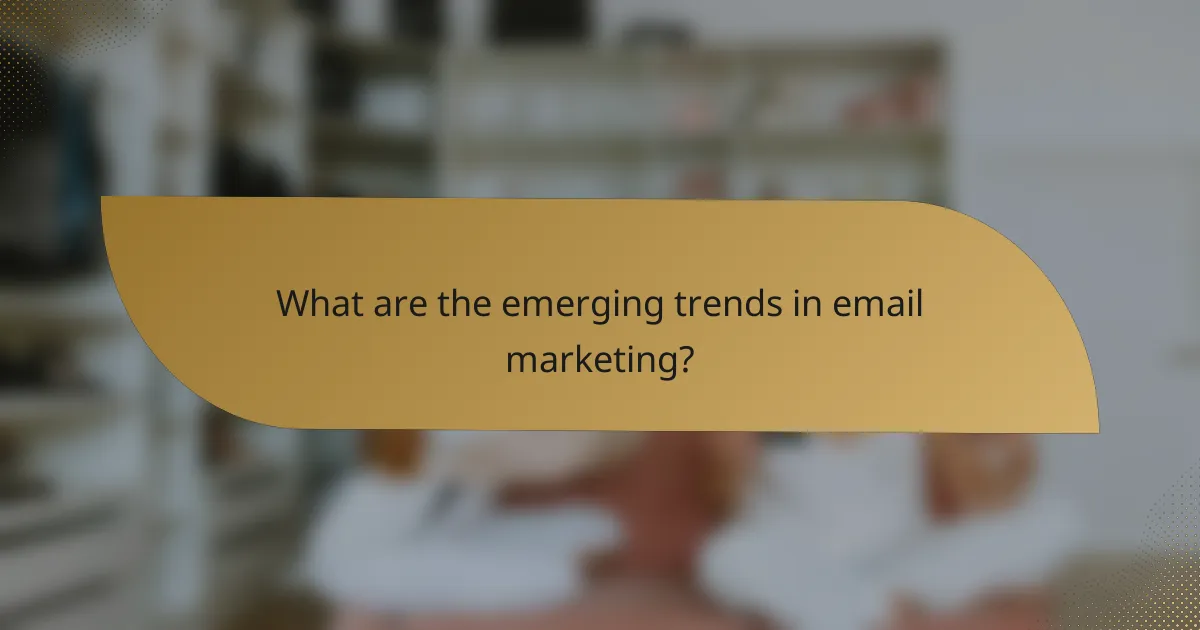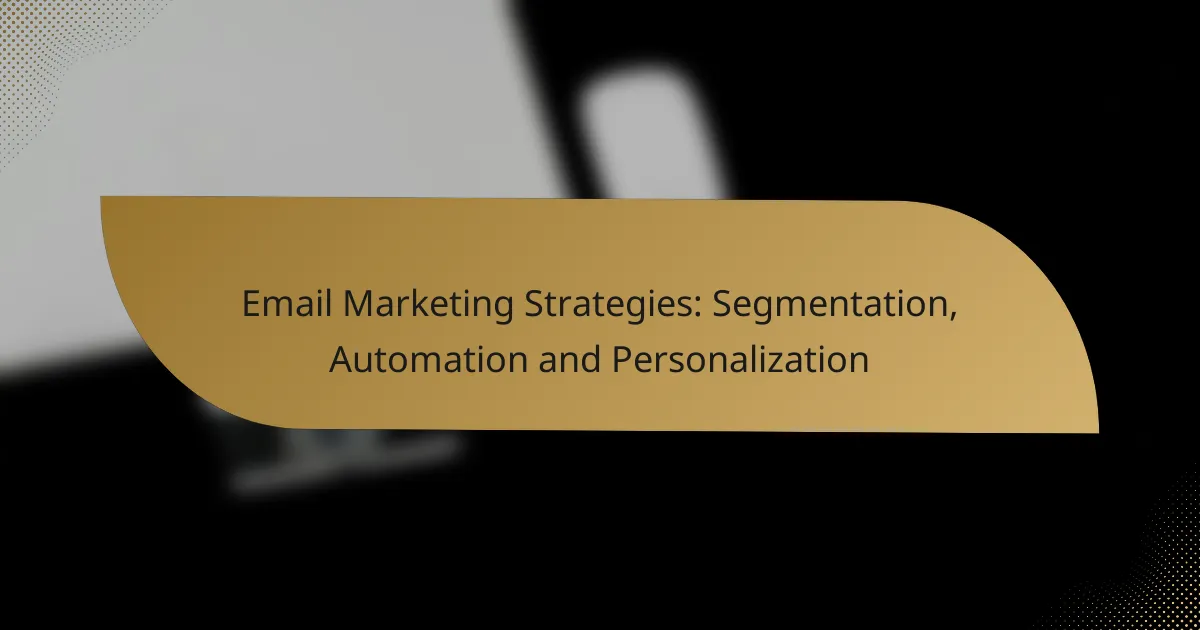Email marketing strategies such as segmentation, automation, and personalization are essential for e-commerce success. By tailoring messages to specific audience groups, businesses can enhance engagement and drive conversions. Automation further streamlines communication, allowing marketers to deliver timely and relevant content based on subscriber behavior and preferences.

What are effective email marketing strategies for e-commerce?
Effective email marketing strategies for e-commerce include segmentation, automation, and personalization. These approaches help businesses target the right audience, streamline their processes, and create engaging content that resonates with customers.
Segmentation for targeted campaigns
Segmentation involves dividing your email list into smaller groups based on specific criteria such as demographics, purchase history, or engagement levels. This allows for tailored messaging that speaks directly to the interests and needs of each segment.
For example, you might create segments for first-time buyers, repeat customers, and cart abandoners. Each group can receive customized offers, increasing the likelihood of conversions and customer loyalty.
Automation for efficiency
Automation streamlines your email marketing efforts by setting up triggers that send emails based on user actions. This can include welcome emails for new subscribers, follow-ups after purchases, or reminders for items left in the cart.
Using automation tools can save time and ensure timely communication with your audience. Aim to automate routine campaigns while maintaining the flexibility to adjust content based on performance metrics.
Personalization for engagement
Personalization enhances engagement by addressing recipients by name and tailoring content to their preferences. This can involve recommending products based on past purchases or sending birthday discounts.
Research suggests that personalized emails can significantly increase open rates and conversions. Utilize customer data to create relevant content that resonates with your audience, fostering a stronger connection with your brand.

How does segmentation improve email marketing?
Segmentation enhances email marketing by allowing businesses to tailor their messages to specific audience groups, leading to more relevant content and better engagement. By dividing your email list based on demographics, behaviors, or preferences, you can create targeted campaigns that resonate with each segment.
Increased open rates
Segmenting your email list can significantly boost open rates. When recipients receive emails that align with their interests or needs, they are more likely to open and engage with the content. For example, a retail brand might segment its list into categories like new customers, loyal customers, and seasonal shoppers, tailoring the subject lines and content accordingly.
To maximize open rates, consider using personalized subject lines that reflect the recipient’s preferences. A/B testing different subject lines within segments can also help identify what resonates best with each group.
Higher conversion rates
Segmentation leads to higher conversion rates by ensuring that the right message reaches the right audience at the right time. When emails are relevant to the recipient’s interests, they are more likely to take action, whether that means making a purchase or signing up for an event. For instance, a travel agency might send tailored offers based on previous travel history or stated preferences.
To improve conversion rates, focus on creating clear calls to action that align with the segmented audience’s needs. Regularly updating your segments based on customer behavior and feedback can also enhance effectiveness, ensuring your campaigns remain relevant and compelling.

What tools can help with email automation?
Email automation tools streamline the process of sending targeted messages to subscribers based on their behavior and preferences. These platforms enable marketers to create workflows that can enhance engagement and improve conversion rates.
Mailchimp for automation workflows
Mailchimp offers a user-friendly interface for setting up automation workflows, making it suitable for beginners and small businesses. Users can create automated emails triggered by specific actions, such as sign-ups or purchases, ensuring timely communication with their audience.
Key features include customizable templates, audience segmentation, and performance tracking. Mailchimp’s pricing is tiered, starting with a free plan that allows basic automation, while more advanced features are available in paid plans ranging from approximately $10 to $300 per month, depending on the number of subscribers.
ActiveCampaign for advanced features
ActiveCampaign is designed for businesses seeking more sophisticated email automation capabilities. It provides advanced segmentation, predictive sending, and detailed analytics, allowing for highly personalized campaigns that can adapt to user behavior over time.
With pricing starting around $9 per month, ActiveCampaign offers a range of plans that scale with your business needs. Its automation builder is particularly powerful, enabling users to create complex workflows that can include multiple triggers and actions, making it ideal for larger organizations or those with specific marketing goals.

How can personalization enhance customer experience?
Personalization significantly enhances customer experience by tailoring content and offers to individual preferences and behaviors. This approach fosters deeper connections, increases engagement, and can lead to higher conversion rates.
Dynamic content for relevance
Dynamic content allows marketers to customize email messages based on user data, such as location, purchase history, or browsing behavior. For instance, an online retailer might showcase different products to customers in various regions, highlighting seasonal items relevant to their climate.
To implement dynamic content effectively, consider using templates that automatically adjust based on user attributes. This can include personalized greetings, product recommendations, or even localized promotions, making the email more relevant and engaging for each recipient.
Behavioral triggers for timely messaging
Behavioral triggers send emails based on specific actions taken by users, ensuring that messages are timely and contextually appropriate. For example, if a customer abandons their shopping cart, an automated reminder email can prompt them to complete their purchase.
To optimize behavioral triggers, identify key actions that indicate intent, such as website visits or previous purchases. Setting up a series of automated responses can nurture leads and encourage conversions, while also providing a seamless experience that feels personal and attentive.

What are the best practices for email list segmentation?
Email list segmentation involves dividing your email subscribers into distinct groups based on specific criteria. This practice enhances targeting and engagement, leading to better campaign performance and higher conversion rates.
Demographic segmentation
Demographic segmentation categorizes your email list based on characteristics such as age, gender, income, education, and location. This approach allows marketers to tailor messages that resonate with specific groups, improving relevance and response rates.
For example, a clothing retailer might send different promotions to young adults compared to older customers, reflecting their distinct fashion preferences. Consider using tools that analyze demographic data to refine your segmentation strategy.
Behavioral segmentation
Behavioral segmentation focuses on subscribers’ interactions with your brand, such as purchase history, email engagement, and website activity. By understanding how customers behave, you can create targeted campaigns that address their specific needs and interests.
For instance, if a customer frequently browses outdoor gear but hasn’t made a purchase, you could send them a personalized offer or content related to outdoor activities. Tracking user behavior can help you adjust your messaging and timing for optimal impact.

How can e-commerce brands measure email marketing success?
E-commerce brands can measure email marketing success through key performance indicators (KPIs) that reflect engagement and financial return. Metrics such as open rates, click-through rates, and return on investment (ROI) provide insights into how well campaigns are performing and where improvements can be made.
Open and click-through rates
Open rates indicate the percentage of recipients who opened an email, while click-through rates measure how many clicked on links within that email. A typical open rate for e-commerce emails ranges from 15% to 25%, and click-through rates often fall between 2% and 5%. Monitoring these rates helps identify which subject lines and content resonate with your audience.
To improve these metrics, consider A/B testing different subject lines and email designs. Personalization, such as addressing recipients by name or tailoring content to their preferences, can also boost engagement. Avoid common pitfalls like sending emails at times when your audience is less likely to check their inbox.
Return on investment (ROI)
ROI measures the profitability of your email marketing efforts by comparing the revenue generated to the costs incurred. A strong email marketing ROI can range from 3:1 to 5:1, meaning for every dollar spent, three to five dollars are earned. This metric helps e-commerce brands assess the effectiveness of their campaigns and allocate resources accordingly.
To calculate ROI, use the formula: (Revenue from email – Cost of email) / Cost of email. Keep track of all associated costs, including design, software, and labor. Regularly review your campaigns to identify which strategies yield the best returns and adjust your approach to maximize profitability.

What are the emerging trends in email marketing?
Emerging trends in email marketing focus on enhancing user engagement and improving conversion rates through innovative techniques. Key strategies include AI-driven personalization, interactive content, and automation, which collectively create a more tailored and dynamic experience for recipients.
AI-driven personalization
AI-driven personalization utilizes artificial intelligence to analyze user behavior and preferences, allowing marketers to send highly relevant content. This approach can significantly increase open and click-through rates by delivering tailored messages based on individual interests.
To implement AI-driven personalization, consider using data analytics tools that track user interactions. For instance, segment your audience based on past purchases or browsing history, and automate email campaigns that recommend products or content aligned with those behaviors.
However, ensure compliance with data protection regulations, such as GDPR in Europe, by obtaining explicit consent for data collection and usage. This builds trust and enhances the effectiveness of your personalized campaigns.
Interactive email content
Interactive email content engages recipients by incorporating elements like polls, quizzes, and embedded videos. This type of content encourages users to interact directly within the email, leading to higher engagement rates and a more memorable experience.
To create interactive emails, use tools that support HTML5 and CSS3, enabling features like clickable buttons and animated graphics. For example, a travel company might include a quiz about travel preferences, allowing users to discover personalized vacation packages based on their answers.
Be cautious with email clients, as not all support interactive features. Always provide a fallback option, such as a link to a web version of the content, to ensure all users can access the information. This approach maximizes engagement while accommodating varying email client capabilities.
